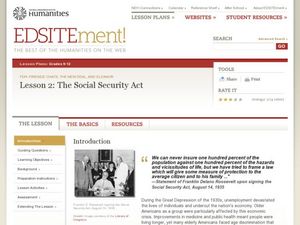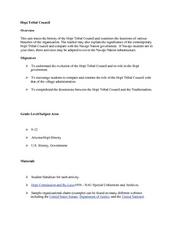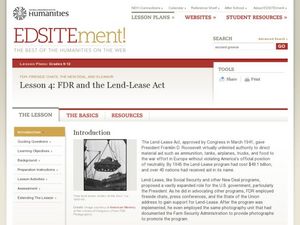Roy Rosenzweig Center for History and New Media
The Homestead Act
To understand how the Homestead Act of 1862 changed the US and the lives of the people during that time, class members examine primary source materials including letters, broadsides, and images. They then assume the voice of a...
Curated OER
Corporate Governance
Examine the role of the Securities Exchange Commission. Upper graders watch a short Bill Moyers video, analyze a political cartoon, complete a graphic organizer on the SEC, and develop SEC reform strategies to rebuild investor confidence.
iCivics
The Road to Civil Rights
Here is a fantastic resource on the civil rights movement! It includes reading materials and worksheets, and particularly highlights major legislation and the role of the judicial branch in the federal government in addressing the...
Curated OER
The Social Security Act
Learners examine the Social Security Act of 1935. In this U.S. history lesson, students research primary sources in order to prepare for a mock debate of the act prior to it becoming legislation.
Curated OER
Jacksonian America and the Indian Removal Act of 1830
Students utilize primary sources to explore the national climate concerning Native American Indians during the Andrew Jackson administration. They are presented with opinions for and against the Indian Removial Act of 1830 as they...
Curated OER
What is the Federal System Created by the Constitution?
Explore the unique structure of the federal system of government in the United States. Class members will learn about how most nations were organized before the establishment of the Constitution, how power is currently divided between...
Center for Civic Education
What Is Authority?
Young scholars examine the concepts of power and authority as they begin learning about government in this elementary social studies lesson. Through a series of readings, discussions, and problem solving activities, children learn about...
Center for Civic Education
What Basic Ideas Are in the Preamble to the Constitution?
Introduce young historians to the US Constitution with this upper-elementary social studies lesson plan. Beginning with a general discussion about the role of government in society, students go on to work in small groups identifying and...
Curated OER
The Stamp Act of 1765
Eleventh graders explore the origins of colonial objections to "taxation without representation". In this American History lesson, 11th graders create a presentation on specific topics in relation to the Stamp Act.
Curated OER
George Washington on the Sedition Act
Students investigate the Sedition Act and George Washington's position on the act. In this United States Colonial history lesson, students read about George Washington's position on the Sedition Act. Students then participate in a...
Curated OER
Types of Government
Students explore different types of government. In this government lesson, students discuss the role of government in modern society, identify different types of modern governments, and play a game based on the information gleaned from...
Curated OER
The Chinese Expulsion Act of 1880
Students examine the Chinese Expulsion Act of 1880. In this History instructional activity, students explore the issues of immigration and exclusion surrounding the Chinese Expulsion Act. Students will use a variety of primary sources to...
Curated OER
Critical Thinking About Government
Students research the Comox Band's system of government and report on what kind of government they think would work for them. In this government lesson plan, students decide between a hereditary system or an election system of...
C-SPAN
How A Bill Becomes A Law
Seven steps are required for a bill to become a United States law. The Families First Coronavirus Response Act (H.R. 6201) is used as a model for the process of how a bill becomes a law. Class members work independently through a Google...
Curated OER
Analyzing Primary and Secondary Sources to Assess the Decisions and Policies of Sitting Bull, Red Cloud, and the U.S. Government
Students examine U.S. policies regarding Native Americans. In this Native American history instructional activity, students analyze provided primary and secondary sources concerning Red Cloud, Sitting Bull, and the Dawes Act. Students...
Curated OER
Race and Representation
Students consider race and representation. In this voting rights lesson plan, students listen to their instructor lecture on the Voting Rights Act of 1965, Georgia congressional districts, and North Carolina voting districts. Students...
Curated OER
Hopi Tribal Council
Focusing on the differences between traditional Hopi government and the Hopi Tribal Council, this resource is a good addition to your unit on Native American culture. Learners conduct Internet research, analyze primary source photos, and...
Smithsonian Institution
Native Resistance: Native Resistance Then and Now
Native Americans lost so much—and gained so little in return. Scholars explore Native Americans' resistance to the United States government. The lesson uses primary sources to explore the different forms of protest and gives a voice to...
Curated OER
How was the Constitution Used to Organize the New Government?
How did the United States Congress determine how the new president and vice president would be named when the nation was first established? Who would provide money for the government, and how would the executive branch be organized?
Curated OER
FDR and the Lend-Lease Act
Pupils analyze primary source documents and photographs to analyze the implications of the Lend-Lease Program. In this research lesson plan, students read and discuss letters and speeches related to the Lend-Lease Act, evaluate FDR's...
Curated OER
The Alien and Sedition Acts: Defining American Freedom
Eleventh graders explore the purpose of the Alien and Sedition Acts. In this US History lesson plan, 11th graders analyze primary source documents. Students write an essay using writing prompts.
Curated OER
Making Sense of the Employee Free Choice Act
Young scholars examine the Employee Free Choice Act. For this workers' rights lesson, students listen to their instructor present a lecture regarding the details of the legislation. Young scholars work in pairs to discuss questions and...
Curated OER
Executive Government: Executive Decision Making
Students explore executive decision making in the federal Cabinet. They are able to explain the need for executive decisions. Students explore how executive decisions are implemented through government departments.
School Improvement in Maryland
Pollution Data
Smog? Vog? What is being done about air pollution? Government classes investigate federal and state programs designed to improve air quality, and then develop a proposal for further actions that are needed.
Other popular searches
- Government Review Activities
- Government Judicial Activism
- Government Act Lesson Plans
- Public Government Activity
- Government Activities

























